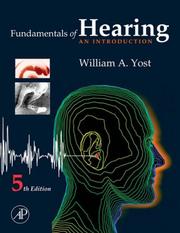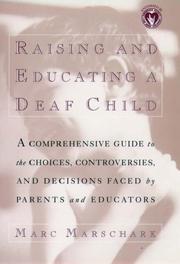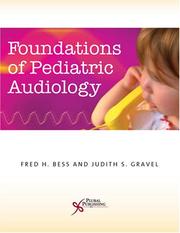| Listing 1 - 10 of 20 | << page >> |
Sort by
|
Book
ISBN: 9780128053980 9780128093498 0128093498 0128053984 Year: 2017 Publisher: London Academic Press
Abstract | Keywords | Export | Availability | Bookmark
 Loading...
Loading...Choose an application
- Reference Manager
- EndNote
- RefWorks (Direct export to RefWorks)
"Hearing Loss: Causes, Prevention, and Treatment covers hearing loss, causes and prevention, treatments, and future directions in the field, also looking at the cognitive problems that can develop. To avoid the "silent epidemic" of hearing loss, it is necessary to promote early screening, use hearing protection, and change public attitudes toward noise. Successful treatments of hearing loss deal with restoring hearing sensitivity via hearing aids, including cochlear, brainstem, or midbrain implants. Both the technical aspects and effects on the quality of life of these devices are discussed. The integration of all aspects of hearing, hearing loss, prevention, and treatment make this a perfect one-volume course in audiology at the graduate student level. However, it is also a great reference for established audiologists, ear surgeons, neurologists, and pediatric and geriatric professionals"--Publisher's description.
Deafness. --- Neoplasms --- Gehoorstoornissen --- Gehoorstoornis
Book
ISBN: 0199313881 9780199313884 1299708889 9781299708884 9780199731961 0199731969 Year: 2013 Publisher: Oxford University Press
Abstract | Keywords | Export | Availability | Bookmark
 Loading...
Loading...Choose an application
- Reference Manager
- EndNote
- RefWorks (Direct export to RefWorks)
This is the third edition of the foremost medical reference on genetic hearing loss, updated to include new information on molecular mechanisms. It is an excellent resource for physicians, audiologists, and other professionals working with individuals with hearing loss and their families, and for clinical training programs and researchers in hearing sciences.
Hearing disorders. --- Deafness --- Congenital deafness --- Auditory disorders --- Defective hearing --- Disorders of hearing --- Hearing defects --- Hearing impairments --- Communicative disorders --- Disabilities --- Ear --- Sensory disorders --- Genetic aspects. --- Diseases --- Gehoorstoornissen --- Erfelijkheidsleer --- Doofheid --- Gehoorstoornis
Book
ISBN: 9781604062564 Year: 2012 Publisher: New York Thieme
Abstract | Keywords | Export | Availability | Bookmark
 Loading...
Loading...Choose an application
- Reference Manager
- EndNote
- RefWorks (Direct export to RefWorks)
According to the National Institutes of Occupational Safety and Health, approximately 30 million employees are exposed to dangerous noise levels at work and an additional nine million workers are at risk for hearing loss from other ototoxins such as metals and solvents. Millions of children and young adults are also at risk for noise-induced hearing loss in non-occupational settings. Hearing Conservation: In Occupational, Recreational, Education, and Home Settingsis the most current text to cover all major topics related to noise-induced hearing loss, including the military, construction, manufacturing, mining, transportation, the music industry, the home environment, education settings, and recreational arenas. From the underlying principles of hearing loss to audiometric testing procedures to assessment of hearing conservation programs, this book is packed with information for audiologists and other members of the interdisciplinary team who provide hearing conservation services for at-risk groups. Special Features: * Many examples of audiometric data, that enhance understanding of all types of hearing impairment, test procedures, and standard threshold shift calculations * Protocols for comprehensive audiological, tinnitus, and auditory processing evaluations * Clinical pathways and follow-up action steps when a standard threshold shift is confirmed, including decisions about worker compensation in occupational settings * Assessment of the effectiveness of a wide range of hearing conservation programs and correction of deficiencies, along with training, educational, and motivational techniques * The most current information about hearing protection and enhancement devices, related regulations, selection and fitting, and training workers in how to use them for optimal results * A set of discussion questions at the end of each chapter that stimulate review and classroom dialogue Comprehensive in scope, easily accessible, and useful to both clinicians and investigators,Hearing Conservation: In Occupational, Recreational, Education, and Home Settings is essential for audiologists, occupational hearing conservationists, otolaryngologists, internists, occupational nurses, noise control engineers, and any other practitioner who plays a role in developing, implementing, and maintaining hearing conservation measures. It is also an excellent text for graduate level audiology courses in hearing conservation.
Book
ISBN: 9781597563000 9781597566209 1597566209 1597563005 Year: 2010 Publisher: San Diego (Cal.) Plural Publishing
Abstract | Keywords | Export | Availability | Bookmark
 Loading...
Loading...Choose an application
- Reference Manager
- EndNote
- RefWorks (Direct export to RefWorks)
Menieres disease is the most poorly understood and controversial of the inner ear disorders and yet no critical review of the literature currently exists. Previously accepted models of pathophysiology have been discredited, yet no new mechanisms have been established. Evaluation of treatments has been complicated by the high placebo response of the disorder together with the diseases capricious clinical course. As a result of all these issues, the literature pertaining to Menieres disease is clouded by anecdotal reports, invalid studies, and science of dubious quality. As a result of these factors, practicing otolaryngologists are understandably confused about how they should best evaluate and treat these patients.
Menière [ziekte van] --- Otorinolaryngologie --- Ménière's disease. --- Aural vertigo --- Endolymphatic hydrops --- Labyrinthine hydrops --- Deafness --- Labyrinth (Ear) --- Vertigo --- Diseases --- Ziekte van Menière

ISBN: 9780123704733 0123704731 9789004501935 9004501932 Year: 2007 Publisher: San Diego (Cal.) Academic Press
Abstract | Keywords | Export | Availability | Bookmark
 Loading...
Loading...Choose an application
- Reference Manager
- EndNote
- RefWorks (Direct export to RefWorks)
The fifth edition of this successful introductory text on hearing sciences includes auditory, anatomy, physiology, psychoacoustics, and perception content. Fundamentals of Hearing is one of only a few textbooks that covers all of hearing at an introductory level. A meaningful introduction to hearing for students and a wealth of data and facts related to hearing for the professional. It it heavily illustrated with over 200 figures. Each chapter concludes with a Supplement section with additional resources about topics covered. Appendices provide background information to enable full comprehension of content. It contains a complete Glossary of terms from the American Standards Institute, a combined subject/author index, and a comprehensive bibliography.
Auditory Perception --- Ear --- Hearing --- Hearing. --- Physiology. --- Anatomy & histology. --- Physiology of nerves and sense organs --- Gehoorstoornissen --- Audiologie --- Acoustics --- Audition (Physiology) --- Physiological acoustics --- Bioacoustics --- Senses and sensation --- Audiology --- Auditory pathways --- Deafness --- Listening --- physiology --- anatomy & histology --- Gehoorstoornis --- Sound perception --- Perception --- Word deafness --- Auditory system --- Head --- Sense organs
Book
ISBN: 1597566985 9781597566988 9781597564410 1597564419 Year: 2012 Publisher: San Diego (Cal.) Plural Publishing
Abstract | Keywords | Export | Availability | Bookmark
 Loading...
Loading...Choose an application
- Reference Manager
- EndNote
- RefWorks (Direct export to RefWorks)
This is the first book written and published that is dedicated solely to hearing loss in older adulthood and, importantly, the processes involved in serving the special needs of older adults who are hearing impaired. It is a concise book, but provides important information for those entering many fields that have as their intent to serve older adults either as a supplement to other texts on communication disorders in aging, or as a concise primary text.
Presbycusis. --- Older deaf people. --- Ear --- Aged, Deaf --- Deaf older people --- Deaf --- Older people --- Hearing loss in old age --- Presbyacousia --- Presbyacusia --- Presbyacusis --- Presbycusia --- Senile deafness --- Deafness --- Aging. --- Aging --- Gehoorstoornissen --- Bejaardenproblematiek --- Doofheid --- Tests (geneeskunde) --- Communicatie --- Audiologie --- #KVHB:Gehoorprothesen --- #KVHB:Gehoorstoornissen --- #KVHB:Ouderen --- Gehoorstoornis --- Ouderenproblematiek --- Test (geneeskunde)

ISBN: 0195094670 Year: 1997 Publisher: Oxford Oxford University Press
Abstract | Keywords | Export | Availability | Bookmark
 Loading...
Loading...Choose an application
- Reference Manager
- EndNote
- RefWorks (Direct export to RefWorks)
Doofheid --- Audiologie --- Onderwijs --- Ontwikkelingspsychologie --- Ouderschap --- Handicaps --- Deaf children --- Parents of deaf children --- Children, Deaf --- Deafness in children --- Hearing impaired children --- Deafblind children's parents --- Deafblind children --- Language --- Patients --- Handicap --- Opvoeding --- Pedagogiek --- Statistische gegevens --- Sport

ISBN: 1597568112 9781597568111 1597561088 9781597561082 Year: 2006 Publisher: San Diego (Cal.) Plural Publishing
Abstract | Keywords | Export | Availability | Bookmark
 Loading...
Loading...Choose an application
- Reference Manager
- EndNote
- RefWorks (Direct export to RefWorks)
Hearing disorders in children. --- Deaf children. --- Children, Deaf --- Deafness in children --- Hearing impaired children --- Communicative disorders in children --- Pediatric otology --- Sensory disorders in children --- Patients --- Pediatrie --- Audiologie --- Research --- Onderzoek --- Onderzoek (wetenschap)
Book
ISBN: 1944883967 9781944883966 9781944883942 1944883940 Year: 2017 Publisher: San Diego (Cal.) Plural Publishing
Abstract | Keywords | Export | Availability | Bookmark
 Loading...
Loading...Choose an application
- Reference Manager
- EndNote
- RefWorks (Direct export to RefWorks)
Written in an engaging, easy-to-read format by three of the industry's leading experts, Speech Mapping and Probe Microphone Measurements is an essential clinical companion for all practitioners fitting and dispensing hearing aids.The key to successful hearing aid fittings is the patient-specific programming of gain and output. As outlined in all Best Practices Guidelines, the cornerstone of this process is the real-ear verification. Although speech mapping and probe-microphone measures have been used clinically for decades, new techniques and procedures continue to emerge. This is the first handbook to be published in 25 years that is dedicated to this critical clinical measure.Starting with an emphasis on evidenced-based practice, and the need to develop a well-researched gold standard, Speech Mapping and Probe Microphone Measurements takes you through the process of conducting valid and reliable speech mapping testing. Following a review of the basics of signal types, presentation levels, and patient and probe positioning, the chapters flow to the patient-centered real-ear verification process. In addition to extensive step-by-step guidelines regarding the routine testing and adjustment of gain and output, protocols for the evaluation of special features and fittings also are outlined. As a bonus, the authors provide a review of how speech mapping findings can be used with other measures that are part of the overall hearing aid fitting protocol.
Hoortoestellen --- Audiometrie --- Gehoorstoornissen --- Hoortoestel --- Gehoorstoornis --- Hearing Aids --- Correction of Hearing Impairment --- Audiometry, Speech --- instrumentation --- Ear Molds --- Aid, Hearing --- Aids, Hearing --- Ear Mold --- Hearing Aid --- Mold, Ear --- Molds, Ear --- Deafness --- Ear Molds, Hearing Aid --- Hearing Aids. --- instrumentation.
Book
ISBN: 1635500125 9781635500127 9781635500110 1635500117 Year: 2018 Publisher: San Diego (Cal.) Plural Publishing
Abstract | Keywords | Export | Availability | Bookmark
 Loading...
Loading...Choose an application
- Reference Manager
- EndNote
- RefWorks (Direct export to RefWorks)
Pediatric Sensorineural Hearing Loss: Clinical Diagnosis and Management is a quick reference manual for pediatricians, residents, audiologists, and others who work with pediatric patients. This text distills the breadth of knowledge on this topic into one that is manageable and easily comprehensible.Pediatric hearing loss is an incredibly complex topic replete with controversies, evolving research findings, and subtle differences in management and diagnosis with different types of hearing loss. Currently, there is no such manual for pediatric hearing loss and the literature that is available can be overwhelming and difficult to read as a quick reference. This text provides practical content for daily clinical use alongside CT and MRI images, audiograms, and algorithms.The chapters distill this complex topic into distinct subsets such as unilateral hearing loss, congenital hearing loss, and sudden sensorineural hearing loss. Pediatric Sensorineural Hearing Loss addresses clinical questions that arise in daily practice by pediatricians and otolaryngologists and can be used by residents for preparation for in-service training exams or as a teaching tool.
Hearing disorders in children. --- Hearing disorders in infants. --- Deafness in children. --- Children, Deaf --- Hearing disorders in children --- Communicative disorders in infants --- Communicative disorders in children --- Pediatric otology --- Sensory disorders in children --- Kinderen --- Gehoorstoornissen --- Kind --- Gehoorstoornis --- Jeugd --- Media --- Ontwikkelingsstoornis --- Fysiotherapie
| Listing 1 - 10 of 20 | << page >> |
Sort by
|

 Search
Search Feedback
Feedback About UniCat
About UniCat  Help
Help News
News